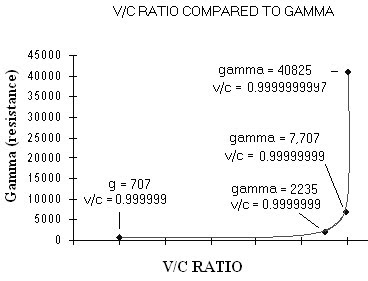The velocity of an electron in orbit is 2 x 10^6 meters per second, and somewhat less in the solar wind. To increase the velocity of these particles beyond this point requires a source of energy. This has been examined in particle accelerators.
It has been proven that the acceleration of the electron requires more energy than expected. It is as if the mass of the particle increases as it approaches the speed of light; however, the mass remains the same.
Relative momentum = (gamma) x mass x velocity
Gamma is the reciprocal of the Lorentz factor as previously discussed, and it is always greater than one, which means “relative” momentum is always greater than mass x velocity.

Gamma reflects the additional energy required to raise the electron to a specified velocity. It is a measure of the resistance met by the electron as it is accelerated. In this equation, v is the velocity of the electron in the accelerator and c is the velocity of light. Gamma increases dramatically as the speed of light is approached. This is shown in the next illustration.

In this illustration, V/C is the ratio of the observed velocity V divided by the velocity of light, C.
As gamma increases from 707 to 40,825 (57.7 fold increase), the velocity of the electron only increases 1.000000999701 fold. Obviously, if the velocity of the electron had increased according to the energy applied, its velocity would have been 57.7 fold greater. This didn’t happen because increasing the velocity of the electron meets with great resistance.
If we live in a three-dimensional world, the question becomes: What is the source of resistance that must be overcome to increase the velocity of the electron? This question can be answered using elastic string theory. Till then be safe and in good health. Kelland—www.vestheory.com
No comments:
Post a Comment